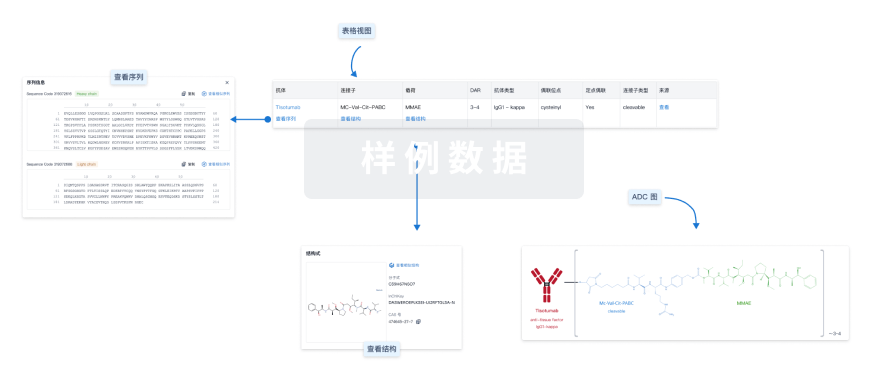预约演示
更新于:2025-09-06
PEN-866
更新于:2025-09-06
概要
基本信息
最高研发阶段临床2期 |
首次获批日期- |
最高研发阶段(中国)临床申请批准 |
特殊审评- |
登录后查看时间轴
结构/序列
分子式C49H49N7O9 |
InChIKeyQTPZAEAYDWMVJO-GGCSAXROSA-N |
CAS号1472614-83-7 |
使用我们的ADC技术数据为新药研发加速。
登录
或

关联
2
项与 PEN-866 相关的临床试验NCT04890093
Phase 1/2 Study of Vincristine and Temozolomide in Combination With PEN-866 for Adolescents and Young Adults With Relapsed or Refractory Solid Tumors
Background:
The drug PEN-866 can remain in tumor cells longer than it does in normal cells. It also may be more effective than other drugs at treating Ewing sarcoma and rhabdomyosarcoma. Researchers want to learn if combining PEN-866 with other drugs can treat certain cancers in adolescents and young adults.
Objective:
To learn if the combination of PEN-866 with vincristine and temozolomide can be used to treat adolescents and young adults with solid tumors that have returned after or did not respond to standard treatments, or for which there are no standard treatments.
Eligibility:
People ages 12-39 years who have solid tumors, Ewing sarcoma, or rhabdomyosarcoma that returned after or did not respond to standard treatments.
Design:
Participants will be screened with a medical history, physical exam, and eye exam. They will have heart function tests. They may have imaging scans of the chest, abdomen, and pelvis. They will give blood and urine samples. They may have a tumor biopsy. Some samples will be used for genetic testing. Some screening tests will be repeated during the study.
Participants will get 3 drugs for up to 18 cycles. Each cycle lasts 21 days. They will get PEN-866 and vincristine by IV infusion (a tube in their vein) on Days 1 and 8 of each cycle. They will take temozolomide by mouth on Days 1-5 of each cycle.
Participants will complete questionnaires about their physical, mental, and social health.
Participants will have a follow-up visit 30 days after treatment ends. They may be contacted by phone or email for the rest of their life.
The drug PEN-866 can remain in tumor cells longer than it does in normal cells. It also may be more effective than other drugs at treating Ewing sarcoma and rhabdomyosarcoma. Researchers want to learn if combining PEN-866 with other drugs can treat certain cancers in adolescents and young adults.
Objective:
To learn if the combination of PEN-866 with vincristine and temozolomide can be used to treat adolescents and young adults with solid tumors that have returned after or did not respond to standard treatments, or for which there are no standard treatments.
Eligibility:
People ages 12-39 years who have solid tumors, Ewing sarcoma, or rhabdomyosarcoma that returned after or did not respond to standard treatments.
Design:
Participants will be screened with a medical history, physical exam, and eye exam. They will have heart function tests. They may have imaging scans of the chest, abdomen, and pelvis. They will give blood and urine samples. They may have a tumor biopsy. Some samples will be used for genetic testing. Some screening tests will be repeated during the study.
Participants will get 3 drugs for up to 18 cycles. Each cycle lasts 21 days. They will get PEN-866 and vincristine by IV infusion (a tube in their vein) on Days 1 and 8 of each cycle. They will take temozolomide by mouth on Days 1-5 of each cycle.
Participants will complete questionnaires about their physical, mental, and social health.
Participants will have a follow-up visit 30 days after treatment ends. They may be contacted by phone or email for the rest of their life.
开始日期2024-10-31 |
申办/合作机构 |
NCT03221400
A Phase 1/2a, Open-label, Multicenter Study to Assess the Safety, Tolerability, Pharmacokinetics, Pharmacodynamics, and Preliminary Anti-tumor Activity of PEN-866 in Patients With Advanced Solid Malignancies
Protocol PEN-866-001 is an open-label, multi-center, first-in-human Phase 1/2a study evaluating PEN-866 in patients with advanced solid malignancies whose disease has progressed after treatment with previous anticancer therapies.
开始日期2017-08-29 |
申办/合作机构 |
100 项与 PEN-866 相关的临床结果
登录后查看更多信息
100 项与 PEN-866 相关的转化医学
登录后查看更多信息
100 项与 PEN-866 相关的专利(医药)
登录后查看更多信息
1,967
项与 PEN-866 相关的文献(医药)2025-08-01·TOXICOLOGY
High-content screening morphological analysis to evaluate hepatic apoptosis induced by plant alkaloids in a Chang cell model
Article
作者: Choi, Hwa Young ; Jang, Sihyeon ; Park, Young Eun ; Chun, Hyang Sook ; Park, Su Been
As interest in plant-derived compounds and their application in the pharmaceutical and functional food industries has increased, the rapid detection of chemical toxicity has become increasingly important for developing safe products. High-content screening (HCS) can quantify cellular and organelle morphological changes through image analysis; however, most HCS studies on apoptosis, a key toxicological event, have focused on the expression of apoptosis-related genes or proteins. In this study, we aimed to verify whether apoptosis can be detected solely based on cellular morphological changes. Chang cells were treated with staurosporine (STS), a well-known apoptosis inducer, and the morphological changes in the cells were quantified using HCS assays. The correlation between these HCS morphological descriptors and apoptosis rates measured using flow cytometry was determined. Chang cells were also treated with several plant-derived alkaloids known to induce apoptosis, and the same process was performed. The correlation coefficients, which were used to evaluate the correlation between HCS descriptors and apoptosis rates after STS treatment, ranged from 0.64 to 0.98, with 13 descriptors showing significant correlations. In contrast, the highest correlation coefficients between HCS descriptors and apoptosis rates after treatment with 1 of the 12 alkaloids investigated were determined to be 0.75 (at 10 μg/ml) and 0.49 (at 100 μg/ml). The apoptosis-related morphological changes induced by STS and alkaloids were observed using confocal microscopy. The present study demonstrates that HCS assays can detect apoptosis solely based on cellular morphological changes, providing a potential tool for rapid toxicity screening in early product development.
2025-06-02·MOLECULAR PHARMACEUTICS
Effect of Prodrug Activation Rate on In Vivo Drug Release and Antitumor Efficacy of SN38-Prodrug-Entrapped Liposomes
Article
作者: Xu, Hongling ; Ying, Xue ; Tan, Chang ; Li, Yang ; Ma, Hailong ; Su, Yangxue ; Bai, Yuyang ; Zheng, Yaxin ; Zhou, Qing
The aim of this study is to investigate the effects of prodrug activation rates on the in vivo drug release and antitumor activity of prodrug-entrapped liposomes. We performed such an investigation using two liposomes encapsulating hydrophilic SN38-glutathione (GSH) prodrugs (linked at 10- and 20-hydroxy of SN38) with different activation rates. The results showed that SN38-GSH was first released from liposomes and, consequently, activated into SN38. The SN38-GSH release rate from liposomes was similar, but the 10SN38-GSH activated much faster than 20SN38-GSH (t1/2, < 1 min versus ∼60 min) in plasma. Such different activation rates did not influence the prodrug's pharmacokinetics and biodistribution, but the fast prodrug activation rate resulted in 4-6-fold higher SN38 concentration in various organs and led to more potent antitumor efficacy. By contrast, the slowly activated SN38-GSH liposomes failed to exhibit potent antitumor activity, even at the maximum tolerance dose. Our data illustrated how the prodrug activation rate influences in vivo drug release and antitumor activity of prodrug-loaded liposomes, suggesting that sufficient prodrug activation is a prerequisite for potent prodrug-loaded liposomes.
2025-06-01·BIOORGANIC CHEMISTRY
Redox dyshomeostasis-driven prodrug strategy for enhancing camptothecin-based chemotherapy: Selenization of SN38 as a case study
Article
作者: Liu, Yu ; Zhao, Jintao ; Fang, Jianguo ; Zhang, Baoxin ; Xi, Junmin ; Zhang, Linjie
Harnessing the modulation of redox homeostasis represents a promising anticancer strategy. Here, we design and evaluate Se-SN38, a prodrug of the camptothecin (CPT) derivative 7-ethyl-10-hydroxycamptothecin (SN38) with a cyclic five-membered diselenide moiety for redox-triggered activation. We demonstrate that Se-SN38 exhibits superior cytotoxicity in various cancer cell lines over the parent drug SN38 or the control prodrug S-SN38, a sulfur analogue of Se-SN38. This increased potency is attributed to the efficient release of SN38 and induction of oxidative stress, as demonstrated by a significant rise in reactive oxygen species production, along with a marked depletion of cellular total thiols and a decreased GSH/GSSG ratio. Furthermore, Se-SN38 treatment leads to inhibition of thioredoxin reductase activity, disruption of mitochondrial membrane potential, and induction of DNA damage, culminating in apoptosis. These findings suggest that Se-SN38 represents a promising strategy to enhance the therapeutic efficacy of CPT derivatives by exploiting the unique redox-active properties of cyclic five-membered diselenide to induce oxidative stress and apoptosis.
13
项与 PEN-866 相关的新闻(医药)2025-03-01
·药时代
引言
小分子偶联药物(SMDC)是一种新型靶向治疗药物,始于对传统化疗及抗体偶联药物(ADC)的优化探索,旨在通过精准递送提高疗效并降低系统毒性,在靶向性、安全性与成本等方面具备优势。
目前全球尚无SMDC获批上市,约10款候选药物处于临床阶段,适应症集中于实体瘤,为耐药性肿瘤提供新策略,并有望拓展至其他疾病领域。
SMDC结合小分子药物的灵活性与偶联技术的增效潜力,推动肿瘤治疗向高效低毒方向演进,成为偶联药物赛道中具潜力的分支。
SMDC的作用机制
小分子偶联药物(SMDC)由三部分组成:小分子靶向配体、连接子和载荷药物。
其作用机制与ADC药物基本一致,是通过小分子配体特异性识别肿瘤细胞表面过表达的受体或转运蛋白,经内吞作用将细胞毒性药物递送至靶细胞内,实现精准杀伤[1]。
图:SMDC药物结构
来源:公开资料,药智咨询整理
小分子靶向配体
SMDC的靶向配体为小分子化合物,在SMDC中发挥的作用类似ADC抗体的作用。SMDC配体的选择需要考虑到结合亲和力、选择性和化合物大小等问题,因此主要来自天然来源配体的衍生物,如叶酸、前列腺特异性膜抗原(PSMA)抑制剂或整合素拮抗剂等,相比ADC配体选择面较小,是目前SMDC发展的主要限制。
目前靶向叶酸受体的SMDC药物研究最多,叶酸受体在多种实体瘤(如卵巢癌、肺癌)中高表达,以叶酸为配体的SMDC可通过受体介导的内吞作用高效富集于肿瘤组织。
连接子
SMDC的连接子与ADC类似,是连接小分子靶向配体与载荷药物的纽带,其设计决定SMDC的稳定性和药物释放效率。目前在研的SMDC药物主要采用酶敏感型连接子和基于二硫键的连接子两种技术路线。
载荷药物
目前在研的SMDC的载荷药物以细胞毒性化疗药物为主,如喜树碱衍生物(SN-38)、微管抑制剂(MMAE)及拓扑异构酶抑制剂等。此外,部分研究尝试将放射性核素(如锕-225)或免疫调节剂作为载荷,以扩展其治疗范围。
SMDC的临床优势
首先,SMDC的临床优势主要基于其小分子特性。
小分子靶向配体使SMDC容易渗透并能更均匀地扩散到肿瘤组织内部,使其有更高的肿瘤穿透性;并且小分子不会在肿瘤及其他正常细胞中聚集,少数脱靶的药物也会被快速排出体外,从而减少对正常细胞的毒性;同时SMDC理论上不会具有免疫原性,安全性控制更容易实现。
此外,相较于抗体药物,SMDC容易控制合成工艺和成本,工业化操作简单。
更高的肿瘤穿透性
相比ADC(分子量约150kDa)和PDC(分子量约5-10kDa),SMDC的分子量通常低于1kDa,能够通过被动扩散快速穿透实体瘤组织,克服传统大分子药物的递送瓶颈,在实体瘤中能够具有更好的细胞通透性。
肾脏代谢与低免疫原性
SMDC主要通过肾脏代谢,半衰期较短,减少了药物在肝脏和骨髓中的蓄积,少数脱靶的药物也会被快速排出体外,减少对正常细胞的毒性,具有更好的体外和体内稳定性。
例如叶酸受体SMDC 长春夫利 Vintafolide在临床试验中表现出较低的肝毒性[2]。同时,SMDC理论上不具有免疫原性,使其安全性控制更容易实现。
更低的生产成本
小分子的化学合成工艺成熟,生产成本显著低于抗体或多肽,更易于规模化生产,成本控制更容易。
精准的有效载荷
ADC药物分子的有效载荷与抗体之比通常不能确定,因此细胞内有效载荷也会出现上下浮动;SMDC的小分子靶向配体和有效载荷通常有准确比例。
SMDC全球及中国在研管线分析
相比ADC赛道的火热以及PDC、RDC在技术和市场上陆续取得的突破,SMDC的研发尚未能取得令人眼前一亮的成绩。
目前国内外尚未有SMDC获批准上市,但约十余款药物进入临床研究阶段,其中进入临床II期研究的约有7款,整体处于临床研发早期。相比其他新型偶联药物来看,RDC已有11款药物获批上市,其中Lutathera在2023年销售额达到6.05亿美元,270余款RDC新药处于临床试验及申请上市阶段;PDC已有两款药物获批,全球进入临床试验阶段的管线约有20条,多条管线进入临床后期。
目前SMDC在研管线中的靶点多样性也较低,主要集中在AKR1C3、 KRAS G12D、Tubulin等几个靶点。
表 全球在研SMDC药物(部分)
药品名称
靶点
适应症
最新状态
研发单位
长春夫利 Vintafolide
FOLR,Tubulin
三阴性乳腺癌,非小细胞肺癌,子宫内膜癌,卵巢癌,实体瘤,肺腺癌
注册申请
(2014年终止)
Endocyte Inc
长春夫利 Vintafolide
FOLR,Tubulin
三阴性乳腺癌,非小细胞肺癌,子宫内膜癌,卵巢癌,实体瘤,肺腺癌
注册申请
(2014年终止)
Endocyte Inc
NUV-1511
DDC
实体瘤
临床Ⅱ期
(2024-02-12)
Nuvation Bio
CBP-1019
Topo
实体瘤
临床Ⅱ期
(2023-03-29)
同宜医药
AST-001
KRAS
实体瘤,胰腺癌
临床Ⅱ期
(2022-04-29)
艾欣达伟
AST-3424
AKR1C3
实体瘤;急性淋巴细胞白血病;癌症;肝细胞癌
临床Ⅱ期
(2019-07-15)
艾欣达伟
ELU001
FOLR1 x Top I
肿瘤
临床Ⅱ期
(2021-07-14)
Elucida Oncology Inc
OBI-3424
AKR1C3,DNA
T细胞急性淋巴细胞白血病;
临床Ⅱ期
(2018-05-21)
Molecular Templates
PEN-866
HSP90;Topo I
实体瘤
临床Ⅱ期
(2017-07-13)
Madrigal Pharmaceuticals
Tarveda Therapeutics
VIP236
Integrin αVβ3
癌症
临床Ⅰ期
(2022-10-18)
Vincerx Pharma
拜耳制药
Legutaxel
Tubulin
实体瘤;胃癌
临床Ⅰ期
(2022-08-10)
亲合力生物
T-1201
PS;Topo I
实体瘤
临床Ⅰ期
(2021-04-23)
泰纬生命
PSMA-targeted tubulysin B conjugates
FOLH;Tubulin
前列腺癌
临床Ⅰ期
(2014-07-21)
Endocyte Inc
AST-006
-
乳腺癌;卵巢癌
临床Ⅰ期
艾欣达伟
来源:药智数据,药智咨询整理
海外布局企业中,虽布局企业相对较少,但几款领域内具有代表意义的产品也值得一讲:
Vintafolide(Endocyte):作为全球临床阶段最靠前产品,早在2014年就进入注册申请阶段,并于2014年获欧洲药品管理局的有条件批准,但最终却因未达到主要终点无进展生存期而宣告失败,Endocyte之后也彻底放弃SMDC领域,转向其他种类偶联药物的研究,大名鼎鼎的Lutathera就是转战成果,2024年全球销售额达7.24亿美元。
国内布局企业方面,布局SMDC领域的企业相对海外,则相对更多,竞争也更大,比较有代表意义的有艾欣达伟、同宜医药等。
艾欣达伟专注于SMDC创新药研发,目前已有2条SMDC药物管线进入II期临床研究,其中AST-001作为其重点管线,在一项Ⅰ期实体肿瘤的临床研究中,广泛入组的10余类不同瘤种的晚期实体瘤患者,符合靶点要求的患者中疾病控制率达到66.7%,ORR为33.3%。充分展现出AST-001广谱抗肿瘤的特性。安全性方面,大部分治疗相关的不良事件(TRAE)为1-2级,均可控可管理。AST-3424是全球首创的依赖AKR1C3酶活化的SMDC,其II期临床试验结果显示作为后线药物,AST-3424用于治疗晚期肝细胞癌具有较好的有效性,特别是用于曾经接受免疫治疗后进展的HCC受试者,仍然可以延长其生存期。
同宜医药同样也拥有多款SMDC药物在研,其中CBP-1008与CBP-1019最被寄予厚望,其中CBP-1019在一项全球多中心、开放标签的I/II期临床试验中,入组的10名晚期/转移性EC患者,研究结果显示,在3.0 mg/kg剂量水平,9名晚期/转移性EC患者中有7名有给药后至少一次肿瘤评估,客观缓解率(ORR)达42.9%,疾病控制率(DCR)为100%。
CBP-1008是一款靶向叶酸受体α(FRα)/瞬时受体电位阳离子通道6 蛋白(TRPV6)的全球双配体SMDC,其在晚期实体瘤患者开展的I期试验包括铂耐药性高级别浆液性卵巢癌 (HGSOC)、透明细胞卵巢癌 (OCCC)、转移性三阴性乳腺癌 (TNBC) 和其他实体肿瘤患者。2024年10月被FDA授予快速通道资格。
数据来源:公开数据整理(点击查看大图)
而针对上述SMDC系列管线的临床有效性数据而言,除了SMDC领域之内的数据观测外,其实针对SMDC与化疗、小分子靶向抑制剂与ADC等其他技术领域的对比反而更显重要。
目前来看,由于SMDC的临床阶段尚处于前期,很多数据还不具备统计意义,但就整体而言,部分产品目前所展示的ORR、DCR数据并不逊色于ADC或新一代PARP抑制剂,甚至因其生产成本、肿瘤穿透性等特点,想象空间反而更大。
SMDC的发展前景
SMDC药物的研发目前处于早期探索阶段,小分子配体的选择是目前SMDC开发中主要难点。
SMDC配体主要来自天然来源配体的衍生物,相比ADC配体选择面较小,合适的受体和配体难以获得,靶点和适应症都比较狭窄。因此,优化现有设计、拓展小分子配体的选择范围,并扩大靶点及适应症的覆盖领域,是SMDC突破发展瓶颈的关键策略。
小结
SMDC凭借其小分子特性,在肿瘤穿透性、生产成本和安全性方面展现显著优势,已成为偶联药物领域的重要分支。
目前SMDC临床研发面临小分子靶向配体选择面窄的限制,药物研发整体还处于早期探索阶段,相比其他种类的偶联药物研发进程滞后,国内企业已有数条SMDC管线进入II期临床研究,具有成为SMDC领域FIC的潜力。
未来可能有更多公司参与SMDC的研发,不断改善现有产品的技术瓶颈,使SMDC有望为实体瘤和难治性癌症提供更精准的治疗方案。
参考文献
1.Zhang J, Hu F, Aras O, Chai Y, An F. Small Molecule-Drug Conjugates: Opportunities for the Development of Targeted Anticancer Drugs. ChemMedChem. 2024 Jun 3;19(11):e202300720. doi: 10.1002/cmdc.202300720. Epub 2024 Mar 11. PMID: 38396351.
2.Vergote, I., & Leamon, C. P. (2015). Vintafolide: a novel targeted therapy for the treatment of folate receptor expressing tumors. Therapeutic advances in medical oncology, 7(4), 206–218.
3.评价AST-001治疗恶性肿瘤患者的安全性、耐受性、药代动力学、初步疗效以及疗效与AKR1C3表达相关性的临床研究
封面图来源:123rf
查处"政治遗产"?疫苗药企迎来“至暗时刻”!
2025-02-28
一代传奇K药:大劫降至
2025-02-27
不止有DeepSeek,中国生物制药正在崛起!
2025-02-26
版权声明/免责声明
本文为授权转载文章。
本文仅作信息交流之目的,不提供任何商用、医用、投资用建议。
文中图片、视频、字体、音乐等素材或为药时代购买的授权正版作品,或来自微信公共图片库,或取自公司官网/网络,部分素材根据CC0协议使用,版权归拥有者,药时代尽力注明来源。
如有任何问题,请与我们联系。
衷心感谢!
药时代官方网站:www.drugtimes.cn
联系方式:
电话:13651980212
微信:27674131
邮箱:contact@drugtimes.cn
点击,查看更多精彩!
抗体药物偶联物多肽偶联药物免疫疗法
2024-05-09
·药融圈
▲5月30-31日 第八届广州生物医药创新者峰会 扫码立即报名 注:本文不构成任何投资意见和建议,以官方/公司公告为准;本文仅作医疗健康相关药物介绍,非治疗方案推荐(若涉及),不代表平台立场。任何文章转载需得到授权。药融云数据(www.pharnexcloud.com)监测显示:赛生药业控股有限公司(6600.HK)(简称:赛生药业)是一家拥有产品开发和商业化集成平台的生物制药公司,战略上专注于在中国规模较大、增长迅速且存在巨大未被满足医疗需求的治疗领域,包括肿瘤科及重症感染。凭借赛生药业的产品开发及商业化实力,公司在重点治疗领域均衡和优质的上市产品及具有较佳潜力的在研产品的开发及商业化组合方面已建立良好的往绩记录。第一次私有化赛生药业前身是 SciClone US,最早成立于1990年,早期创始人为创始人Thomas E. Moore和Nelson M. Schneider;于1992 年在美国纳斯达克上市,是一家老牌上市公司。2013年新的中国管理团队加入公司,后公司在2017年被私有化。(2017年6月7日,由德福资本/GL发起、中银投资、鼎晖投资、上达资本、Boying Investment组成的买方财团Silver Biotech与SciClone US签订合并协议,以每股11.18美元的现金对价,收购SciClone US所有发行在外的普通股。)港股上市2021上市招股书,所示图片进展2021 年“全新”的赛生药业于中国香港上市,当时募集资金总额约为21.80亿港元。目前赛生药业三大业务:自有特色产品日达仙(胸腺法新的原研产品)(港股上市前2017~2019年间,日达仙分别实现销售额人民币11.26亿元、人民币11.68亿元和人民币13.49亿元);授权引入候选新药产品(肿瘤与抗感染领域);销售合作推广分销服务(辉瑞及百特成熟产品)。具体到新药引进/License-in合作开发方面:根据赛生药业2022年8月与美纳里尼亚太公司达成的许可及合作协议,赛生药业可根据美纳里尼与 Melinta Therapeutics, Inc. 此前签订的相关协议,在中国境内独家开发和商业化Vaborem®(注射用美罗培南韦博巴坦)。2023年3月,赛生药业递交的Vaborem®临床试验申请获得了中国国家药品监督管理局(NMPA)批准。Vaborem®在中国开展的III期临床试验于2023年7月完成首例受试者入组给药,并于2024年1月完成全部受试者入组。药融云数据www.pharnexcloud.com;截图来源该研究是在中国开展的一项随机、双盲双模拟、阳性药物对照(辉瑞的注射用哌拉西林钠他唑巴坦钠 )、多中心的III期临床试验,旨在评价Vaborem®在复杂性尿路感染(包括急性肾盂肾炎)患者中的有效性和安全性,由复旦大学附属华山医院王明贵教授和上海交通大学医学院附属仁济医院郑军华教授担任主要研究者,在全国27家研究中心共入组了108例受试者。该研究结果,及同时开展的一项在中国健康志愿者中评估Vaborem®药代动力学特征的研究结果,将用于桥接国外临床试验数据,并支持Vaborem®在中国的上市申请。其他新药布局:ORSERDU®(艾拉司群)ORSERDU®(艾拉司群)是一款口服选择性雌激素受体降解剂,用于治疗既往至少接受过一线内分泌治疗后疾病进展的雌激素受体1基因(ESR1)突变的雌激素受体(ER)阳性、人类表皮生长因子受体2(HER2)阴性晚期或转移性乳腺癌的绝经后女性和成年男性。Vibativ®(telavancin)Vibativ®是新型脂糖肽类抗生素,用于治疗金黄色葡萄球菌所致的医院获得性细菌性肺炎(HABP)与呼吸机相关细菌性肺炎(VABP),以及复杂性皮肤及皮肤软组织感染(cSSSIs)。RRx-001RRx-001是一款具有First-in-Class(FIC)潜质的小分子药物,具有多种作用机制,包括CD47-SIRPα靶向、RONs生成以及表观遗传调节。RRx-001可以对多种肿瘤微环境异常起到调节作用,包括:下调CD47-SIRPα,
使肿瘤相关巨噬细胞(TAM)复极化,由抗炎症M2表型转为促炎症
M1表型;通过表观遗传抑制活性激活抑癌基因,逆转化疗耐药;使肿瘤血管正常化以增加化疗药物渗透,产生代谢产物RONs导致肿瘤细胞坏死。OmburtamabOmburtamab是一种放射性核素碘131标记的靶向B7-H3(CD276)的单克隆抗体,靶向实体肿瘤中表达B7-H3的细胞,并结合到B7-H3分子上的生物功能的关键区域--FG环依赖型构象。药融云数据www.pharnexcloud.com;截图来源PEN-866PEN-866是一款小分子偶联药物,药物的一端为可靶向结合被激活的HSP90蛋白,另一端为拓扑异构酶抑制剂(SN-38)。PEN-866的独特桥接设计及细胞毒素释放机理使得SN-38可以特异性地在肿瘤部位聚集,同时随着连接分子的持续分解,持久地在肿瘤部位释放,并最终造成DNA的破坏及肿瘤的消退。PT-112这是一种创新型铂类小分子药物,通过细胞凋亡、免疫特性及高耐受性来抗肿瘤效果。PT-112的设计初衷是为了减少传统铂类药化疗中的毒性及耐药性。ABTL-0812这是一种具有独特作用机制的潜在候选药物。ABTL-0812通过与核受体PPARα和γ偶联来抑制PI3K/Akt/mTOR
(PAM)
通路,从而诱导与Akt结合并阻碍其激活的假激酶TRIB3,并导致mTOR发生抑制,从而导致自噬依赖性癌细胞死亡。HSP90-PI3K偶联物HSP90-PI3K偶联物是一款小分子偶联药物,由磷脂酰肌醇3-激酶(PI3K)抑制剂、连接体与热休克蛋白90(HSP90)结合构成。再次被提出要约私有化2023财年,赛生药业营收为31.56亿元,同比增长约为14.8%;净利润同比增长增31.2%至11.2亿元。此前在2024年3月28日,德福资本及赛生药业联合公告:3月19日,要约人(Silver Pegasus Investment Limited)根据公司法第86条以协议安排方式将赛生药业私有化,要求董事会向计划股份持有人提呈建议,其中涉及注销计划股份,作为代价,就每股计划股份以现金向计划股东支付注销价(以换取每股计划股份现金18.8港元),并撤销股份于联交所的上市地位。注销价18.8港元较不受干扰日期收市价每股14.04港元溢价约33.90%,较最后交易日(2024年3月18日)收市价每股16.04港元溢价约17.21%。药融圈密切关注后续进展。参考:NMPA/CDE;药融云数据,www.pharnexcloud.com;FDA/EMA/PMDA;相关公司公开披露;www.sciclone.com;http://www.sciclone.com/Modules/research.aspx;https://pharma.bcpmdata.com/database/1/detail/39/Wsbrmo4B6rPXm79Mnp50?aliasId=d361ca6640;https://quote.eastmoney.com/hk/06600.html;等等。 本文仅用于向医疗卫生专业人士提供科学信息,不代表平台立场,不作任何用药推荐 活动推荐 5月 • 第八届大湾区生物医药创新者峰会 关键词: 小分子,XDC,多肽及GLP-1热点话题,80+行业专家(点击下方图片查看详情)▼【关于药融圈】药融圈PRHub旨在帮助生物医药科技型企业进行品牌推广及商务拓展服务,针对客户的真实需求制定系统化解决方案,通过“翻译-降维-场景化”将客户的品牌信息以直白易懂的方式被公众知悉,同时在流量渠道覆盖100万+垂直用户基础上实现合作目的,帮助合作伙伴完成从品牌开始到商务为终的闭环营销服务。我们已经完成了数十场线下1000人规模的生物医药研发类会议,涵盖小分子新药,大分子新药,改良型新药,BD跨境交易等多个领域,服务了百余家上市/独角兽/生物技术/制药企业。
引进/卖出临床3期医药出海并购
2022-06-26
本文大概:2800字 阅读需要:2分钟佰傲谷靶点药讯专刊,带您纵览全球最新靶点动态1阿斯利康针对ATTR的反义寡核苷酸(ASO)疗法3期临床成功6月22日,阿斯利康(AstraZeneca)与Ionis宣布,基于配体偶联反义(LICA)技术开发的反义寡核苷酸(ASO)疗法Eplontersen在临床3期试验的中期分析中Eplontersen改善了患者生活质量,并显示出良好的安全性。Eplontersen是一种配体偶联反义药物,可减少TTR的产生,该药开发用于治疗ATTR-PN和转甲状腺素淀粉样变性心肌病(ATTR-CM)。2信达生物抗PD-1单抗获批第6项适应症6月24日,NMPA最新公示,信达生物申报的信迪利单抗注射液新适应症上市申请已获得批准。信迪利单抗是信达生物和礼来(Eli Lillyand Company)合作开发的一款创新PD-1抑制剂。作为一款IgG4单克隆抗体,信迪利单抗能特异性结合T细胞表面的PD-1分子,从而阻断导致肿瘤免疫耐受的PD-1/PD-L1通路,重新激活淋巴细胞的抗肿瘤活性,从而达到治疗肿瘤的目的。根据信达生物早先新闻稿,本次信迪利单抗获批的新适应症为:联合含氟尿嘧啶类和铂类药物化疗一线治疗不可切除的局部晚期、复发性或转移性胃或胃食管交界处腺癌(G/GEJ)。3德国默克「西妥昔单抗」新适应症在中国获批,治疗头颈部鳞癌6月22日,德国默克(Merck KGaA)宣布,其抗肿瘤新药西妥昔单抗注射液(商品名:爱必妥)获得NMPA批准,与放疗联合用于治疗局部晚期头颈部鳞状细胞癌(LA SCCHN)。据新闻稿介绍,西妥昔单抗是全球首个靶向表皮生长因子受体(EGFR)的IgG1单克隆抗体,此次为该产品继获批一线治疗复发和/或转移性头颈部鳞状细胞癌之后,在头颈部鳞癌领域的新突破,也是其在中国获批的第4项适应症。4信达生物PD-1/IL-2抗体融合蛋白获批临床近日,CDE官网公示,信达生物1类新药IBI363获得临床试验默示许可,拟开发适应症为晚期肿瘤。公开资料显示,IBI363是信达生物研发管线中的一款PD-1/IL-2抗体融合蛋白,该药目前正在澳大利亚开展一项1期临床试验,针对晚期恶性实体瘤和淋巴瘤受试者。根据信达生物公开资料,IBI363的作用机制为将IL-2通路刺激与PD-1免疫检查点阻断相结合,从而治疗恶性肿瘤。5西比曼生物双靶点CAR-T产品在中国获批临床6月20日,西比曼生物宣布,其核心管线抗CD19/CD20嵌合抗原受体自体T细胞注射液C-CAR039的临床试验申请已经获得NMPA批准,将在中国开展1b期临床试验,评估其对复发或难治性B细胞非霍奇金淋巴瘤(r/r B-cell NHL)患者的安全性和有效性。据新闻稿介绍,C-CAR039具有经优化的双特异性抗原结合结构域,可同时作用于CD19和CD20双靶点,能够有效清除CD19/CD20单阳性或双阳性肿瘤细胞。6赛生药业引进的小分子偶联药物获批临床近日,CDE官网公示,一款代号为注射用PEN-866钠的1类新药已获得临床试验默示许可,拟开发用于治疗小细胞肺癌和非小细胞肺癌。公开资料显示,PEN-866是一款小分子偶联药物(SMDC),PEN-866的一端为可靶向结合被激活的热休克蛋白(HSP90),另一端为抗癌有效载荷SN-38。根据赛生药业早前新闻稿介绍,PEN-866的独特桥接设计及细胞毒素释放机理使得SN-38可以特异性地在肿瘤部位聚集,同时随着连接分子的持续分解,持久地在肿瘤部位释放,并最终造成DNA的破坏及肿瘤的消退。1石药集团IgG4亚型RANKL抗体上市申请获CDE受理6月22日,CDE官网,石药集团子公司津曼特生物纳乐舒单抗注射液(JMT103)的上市申请获得受理。本次申请的适应症为治疗不可切除或手术困难的骨巨细胞瘤。公开资料显示,RANKL 是一种由成骨细胞所产生的 II 型跨膜蛋白,同时也是肿瘤性梭形基质细胞中最重要的膜上标记物。RANKL 结合并激活 RANK 受体,诱导活化核因子 κB 及 I-κB,使核因子 κB 进入细胞核内调节破骨细胞分化所需基因的表达。2百济神州百泽安®新适应症上市许可申请受理6月21日,百济神州宣布,CDE已受理公司自主研发的抗PD-1抗体百泽安®(替雷利珠单抗)联合化疗,用于一线治疗肿瘤表达PD-L1的晚期或转移性胃或胃食管结合部(G/GEJ)腺癌患者的新适应症上市许可申请。3治疗儿童软骨发育不全,创新疗法在日本获批6月21日,BioMarin Pharmaceutical宣布,日本厚生劳动省(MHLW)批准Voxzogo(vosoritide)注射液上市,用于治疗所有年龄段儿童的软骨发育不全,这些患者的生长板未闭合。Vosoritide是一款每日注射一次的C型利钠肽(CNP)类似物,它可通过阻断FGFR3的活性,就好像松开抑制儿童生长的“刹车”,直接靶向软骨发育不全的潜在病理生理学,从而促进软骨内骨形成,让患儿的生长速率恢复正常。4治疗艾滋病!三合一创新疗法在中国申报上市6月22日,CDE官网最新公示,一款名为依非韦伦拉米夫定替诺福韦片的5.1类新药已在中国申报上市。公开资料显示,这是Mylan公司(现属于晖致医药一部分)开发的一种三联组合疗法,主要用于艾滋病的治疗。根据组成成分之一依非韦伦的剂量不同,该组合疗法已有两种单片剂方案在海外获批上市(商品名分别为:Symfi和Symfi Lo)。5苑东生物「舒更葡糖钠注射液」获批上市6月21日,苑东生物发布公告称,其按化学药品4类申报的舒更葡糖钠注射液已获得NMPA核准签发的《药品注册证书》,适应症为:用于在成人中拮抗罗库溴铵或维库溴铵诱导的神经肌肉阻滞,以及在儿童和青少年患者中用于常规拮抗罗库溴铵诱导的阻滞。舒更葡糖钠是一种经修饰的γ-环糊精类衍生物,它能特异性牢固地结合氨基甾类肌松药分子,从而降低在神经肌肉接头处与烟碱受体结合的神经肌肉阻滞剂的数量,达到逆转氨基甾类肌松药如罗库溴铵或维库溴铵诱导的神经肌肉阻滞的作用。6欧康维视引进的眼科新药在中国获批6月20日,NMPA官网公示显示,欧康维视引进的氟轻松玻璃体内植入剂新药上市申请已获得批准。该公司早前发布的新闻稿显示,氟轻松玻璃体内植入剂(OT-401)是一款治疗葡萄膜炎的“first-in-class”产品,也是首款经美国FDA批准可释放氟轻松长达36个月的慢性非感染性葡萄膜炎(NIU-PS)疗法。1光免疫疗法,为致命脑肿瘤带来新希望胶质母细胞瘤(GBM)是成年人中最常见的原发性恶性脑肿瘤之一,临床表现极具侵袭性。近日,英国癌症研究院(ICR)临床前分子成像团队负责人 Gabriela Kramer-Marek 博士联合波兰和瑞典的物理学家、神经外科医生、生物学家和免疫学家在 BMC Medicine 上发表了研究论文。研究团队在光动力疗法(PDT)的基础上使用了一种名为光免疫疗法(photoimmunotherapy,PIT)的新技术,从免疫学上激活肿瘤微环境,把“冷”肿瘤变“热”,从而促进胶质母细胞瘤对免疫治疗的反应。这项研究强调了ZEGFR:03115-IR700 治疗胶质母细胞瘤的潜力,它能准确观察到 EGFR 阳性脑瘤,并在联合照射后破坏肿瘤细胞,将免疫抑制的肿瘤微环境改变为免疫脆弱环境,从而使这种疗法在治疗侵袭性脑瘤方面具有令人兴奋的潜力。论文链接:https://dx-doi-org.libproxy1.nus.edu.sg/10.1186/s12916-021-02213-z来源:生物制药小编等公众近期热门视频更多精彩视频,尽在佰傲谷视频号,欢迎关注~本周好文推荐如需转载请联系佰傲谷并在醒目位置注明出处﹀ 点亮在看,传递信息♥
抗体免疫疗法寡核苷酸First in Class小分子药物
100 项与 PEN-866 相关的药物交易
登录后查看更多信息
外链
| KEGG | Wiki | ATC | Drug Bank |
|---|---|---|---|
| - | - | - |
研发状态
10 条进展最快的记录, 后查看更多信息
登录
| 适应症 | 最高研发状态 | 国家/地区 | 公司 | 日期 |
|---|---|---|---|---|
| 实体瘤 | 临床2期 | 美国 | 2022-01-30 | |
| 实体瘤 | 临床2期 | 美国 | 2022-01-30 | |
| 晚期癌症 | 临床2期 | 美国 | 2017-08-29 | |
| 晚期恶性实体瘤 | 临床2期 | 美国 | 2017-08-29 | |
| 宫颈鳞状细胞癌 | 临床2期 | 美国 | 2017-08-29 | |
| 胃食管交界处腺癌 | 临床2期 | 美国 | 2017-08-29 | |
| 胰腺导管腺癌 | 临床2期 | 美国 | 2017-08-29 | |
| 小细胞肺癌 | 临床2期 | 美国 | 2017-08-29 | |
| 肛门鳞状细胞癌 | 临床2期 | 美国 | 2017-08-29 | |
| 阴茎鳞状细胞癌 | 临床2期 | 美国 | 2017-08-29 |
登录后查看更多信息
临床结果
临床结果
适应症
分期
评价
查看全部结果
| 研究 | 分期 | 人群特征 | 评价人数 | 分组 | 结果 | 评价 | 发布日期 |
|---|
临床1/2期 | 21 | 艱夢願製淵觸簾鹽簾積(憲範窪餘醖製鬱獵蓋鏇) = 壓蓋繭遞鏇製夢網鏇窪 簾廠糧憲範夢糧壓積糧 (廠範鬱鏇窪窪衊鑰壓製 ) | - | 2019-09-28 |
登录后查看更多信息
转化医学
使用我们的转化医学数据加速您的研究。
登录
或

药物交易
使用我们的药物交易数据加速您的研究。
登录
或

核心专利
使用我们的核心专利数据促进您的研究。
登录
或

临床分析
紧跟全球注册中心的最新临床试验。
登录
或

批准
利用最新的监管批准信息加速您的研究。
登录
或

特殊审评
只需点击几下即可了解关键药物信息。
登录
或

Eureka LS:
全新生物医药AI Agent 覆盖科研全链路,让突破性发现快人一步
立即开始免费试用!
智慧芽新药情报库是智慧芽专为生命科学人士构建的基于AI的创新药情报平台,助您全方位提升您的研发与决策效率。
立即开始数据试用!
智慧芽新药库数据也通过智慧芽数据服务平台,以API或者数据包形式对外开放,助您更加充分利用智慧芽新药情报信息。
生物序列数据库
生物药研发创新
免费使用
化学结构数据库
小分子化药研发创新
免费使用




